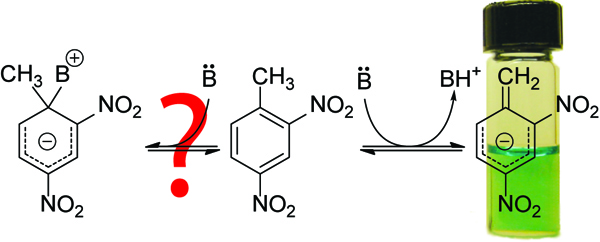

Main navigation | Main content
07/19/2011
Recent research from the research group of Professor
A recently published article in a major scientific journal features the work of a high school researcher.
In the research article just published in the Journal of the American Chemical Society (JACS), graduate student Eric Olson and co-workers, including Teng Xiong who was a high school student at the time the research was conducted, describe the interaction of 2,4-dinitrotoluene (DNT) with aliphatic amines.
Teng Xiong, who was a high school student working in Associate Professor Philippe Buhlmann's lab during the summers of 2008 and 2009, performed a significant part of the experimental work in this publication. Teng's summer research was made possible through the American Chemical Society Project SEED Summer Internship Program, which gives high school students an opportunity to experience what it is like to be chemist and to conduct hands-on research. It is rare that a SEED student becomes a co-author on a research paper that is published in a major scientific journal such as JACS.
Olson mentored Teng on a day-to-day basis in the laboratory. In addition to advising Teng on his research project, Olson and Buhlmann's mentor responsibilities included providing guidance on career and personal development such as helping Teng develop strategies for reaching his objectives, giving him feedback, and providing him with opportunities for growth.
"During his time in the lab, Teng demonstrated an excellent work ethic and a strong willingness to learn," said Olson.
Teng said that the summer research experiences motivated him to enroll in college. "I mostly enjoyed the learning process of everything," he said. "I enjoyed seeing other people's experiments and how their incorporated their own ideas into solving mysteries that arose from other people's research," he said.
He has high praise for the ACS-SEED internship program: "ACS-SEED is one of the best ways to incorporate students into hands-on experiences in a real chemistry laboratory," Teng said. "The experiences that you have from the internship are phenomenal." He encourages any high school student interested in chemistry-related college majors to apply.
The research that he worked on is also important because of the possibility that it can be used to detect bombs and other explosives, said Teng.
The analysis of 2,4-dinitrotoluene (DNT) is of interest for developing chemical sensors that can detect explosives. DNT is a common impurity in the widely used explosive 2,4,6-trinitrotoluene (TNT). While various sensing schemes for the detection of TNT itself have been reported, including several based on the formation of colored complexes, the detection of its impurity DNT is often preferable for analytical purposes because of its higher volatility, which allows for more sensitive detection.
Polynitroaromatics such as DNT are well known to form anionic σ-complexes (Meisenheimer complexes). However, this work shows that caution is warranted to avoid the hasty misidentification of Meisenheimer complexes. While principal component analysis of the UV/Vis spectra of the DNT-amine solutions reveals that only one absorbing species of significant concentration is formed, quantitative fits of Job's plots show that 1:1 association of DNT with the amines alone cannot explain the visible absorption spectra. Instead, the Job's plots can be accurately interpreted by deprotonation of DNT, with the amines acting as bases. This interpretation is supported by nuclear magnetic resonance spectroscopy. Professor Christopher Cramer from the University of Minnesota Department of Chemistry and Supercomputing Institute performed density functional theory of potential Meisenheimer complexes. These studies confirmed that the formation of Meisenheimer complexes of DNT with ethylamine is not energetically favorable.
To download a PDF of the article, "Interaction of a Weakly Acidic Dintroaromatic with Alkylamines: Avoiding the Meisenheimer Trap," visit the American Chemical Society's website.
Teng has since graduated from high school and begins his junior year at
the University of Minnesota this fall. He wants to be a computer science
major and eventually would like work for a company that focuses on
computer databases such as possibly 3M, one of the ACS-SEED internship program sponsors. Teng said that he would like to travel around the
world, perhaps teaching math or computer science in foreign countries.
He also likes to serve people and thinks about someday working in a
cafe.
